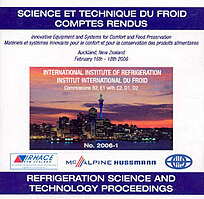
Document IIF
Modèles alternatifs pour prévoir la conductivité thermique des produits alimentaires surgelés.
Alternative models to predict the thermal conductivity of frozen foods.
Auteurs : WANG J. F., CARSON J. K., NORTH M. F., et al.
Résumé
For two component materials, combinations of 5 fundamental effective thermal conductivity structural models (series, parallel, two forms of Maxwell-Eucken, effective medium theory) were wed to define 26 new models, each with a distinct and unique structure. The predictions of these models were compared to measured values for 22 high-moisture-content foods between -40 and -1°C. Near the initial freezing temperature, the accuracy of the models was constrained by the precision of the ice fraction model wed. Overall, the most accurate model was a combination of the parallel, Maxwell-Eucken (with ice as the dispersed phase) and series structures. However, other combined models were only slightly less accurate, and were superior to the Levy model which has previously been recommended for such foods. The final assessment of the best models for frozen foods will require information on ice fraction and structural features in addition to accurate measured thermal conductivity data.
Documents disponibles
Format PDF
Pages : 2006-1
Disponible
Prix public
20 €
Prix membre*
Gratuit
* meilleur tarif applicable selon le type d'adhésion (voir le détail des avantages des adhésions individuelles et collectives)
Détails
- Titre original : Alternative models to predict the thermal conductivity of frozen foods.
- Identifiant de la fiche : 2007-0707
- Langues : Anglais
- Source : Innovative Equipment and Systems for Comfort and Food Preservation.
- Date d'édition : 16/02/2006
Liens
- Voir les traductions : La conductividad térmica en alimentos congelados: modelos alternativos para su predicción.
Voir d'autres communications du même compte rendu (51)
Voir le compte rendu de la conférence
Indexation
-
Thèmes :
Ingénierie alimentaire;
Congélation des aliments - Mots-clés : Conductivité thermique; Produit alimentaire; Simulation; Produit congelé; Modélisation
-
Modelling thermal conductivity of frozen foods ...
- Auteurs : TARNAWSKI V. R., BOVESECCHI G., COPPA P., et al.
- Date : 21/08/2007
- Langues : Anglais
- Source : ICR 2007. Refrigeration Creates the Future. Proceedings of the 22nd IIR International Congress of Refrigeration.
- Formats : PDF
Voir la fiche
-
SIMULTANEOUS DETERMINATION OF THERMAL CONDUCTIV...
- Auteurs : DOMINGUEZ M., et al.
- Date : 10/08/1991
- Langues : Anglais
- Source : New challenges in refrigeration. Proceedings of the XVIIIth International Congress of Refrigeration, August 10-17, 1991, Montreal, Quebec, Canada.
- Formats : PDF
Voir la fiche
-
Predicting the thermal conductivity of low wate...
- Auteurs : CARSON J. K., WANG J. F., NORTH M. F., et al.
- Date : 21/08/2011
- Langues : Anglais
- Source : Proceedings of the 23rd IIR International Congress of Refrigeration: Prague, Czech Republic, August 21-26, 2011. Overarching theme: Refrigeration for Sustainable Development.
- Formats : PDF
Voir la fiche
-
Simulation of the thawing of a gelatin gel cyli...
- Auteurs : MONTEAU J. Y., LAURENCEAU J.
- Date : 26/06/2000
- Langues : Anglais
- Source : FOODSIM'2000. 1st International Conference on Simulation in Food and Bio industries.
Voir la fiche
-
Effective thermal conductivity models for foods...
- Auteurs : CARSON J. K.
- Date : 16/02/2006
- Langues : Anglais
- Source : Innovative Equipment and Systems for Comfort and Food Preservation.
- Formats : PDF
Voir la fiche
